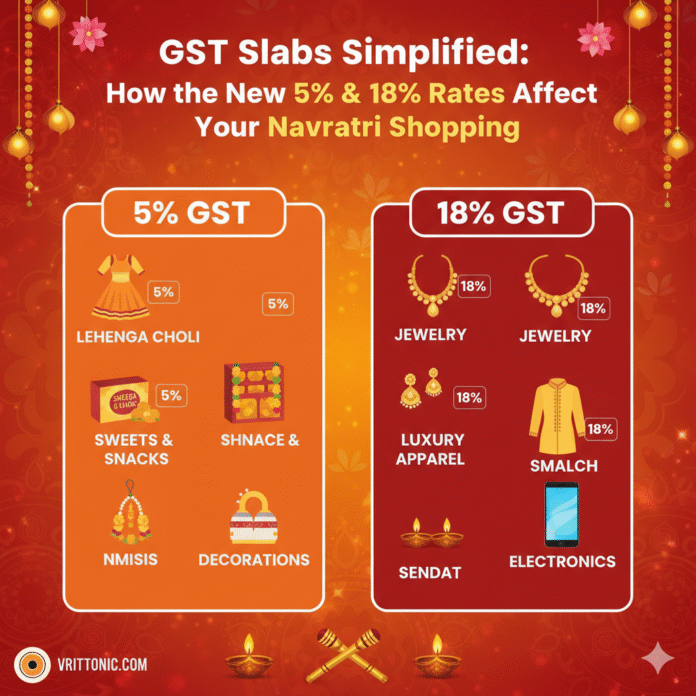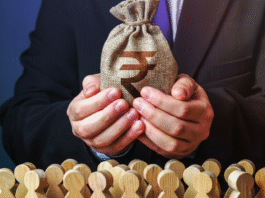Navratri is here, and with it comes a massive shake-up in India’s tax landscape. The new GST rates are now LIVE, and this isn’t just a minor tweak—it’s a total game-changer. Following the 56th GST Council meeting, the government has streamlined the old four-slab structure into just two main rates: 5% and 18%. This is a big win for consumers, as many daily essentials, household goods, and even vehicles are getting cheaper. Prime Minister Narendra Modi even dubbed it a “GST Savings Festival.” Prime Minister Narendra Modi on Sunday hailed the GST rate cuts
So, what does this mean for you? Ultimately, this reform is about making life easier and more affordable for the common person. The shift is designed to boost consumption and provide a much-needed push to the economy. This comprehensive guide will break down all the key changes. We’ll look at what’s getting cheaper, what’s getting pricier, and how this “GST 2.0” will impact your wallet this festive season.
1. Daily Essentials: Your Pantry Just Got a Boost 🛒
This is the big one. Your monthly grocery bill is about to get a lot friendlier. Many items that were previously taxed at 12% are now moving to the 5% slab. This is a massive relief for every household.
What’s Cheaper?
- Dairy Products: Ghee, butter, cheese, and condensed milk are now more affordable.
- Packaged Foods: Get ready to save on things like namkeen, sauces, jams, and ready-to-eat snacks.
- Dry Fruits & Nuts: Almonds, pistachios, dates, and other dried fruits are now subject to a lower tax.
This is a major move towards simplifying the tax system and putting money back into the consumer’s pocket. In a similar vein, basic goods that were at 18% are also coming down. Think of products like toiletries and personal care items.
What Else Is Cheaper?
- Hygiene & Grooming: Toothpaste, soaps, shampoos, hair oil, and shaving creams are all shifting from 18% to 5%.
- Healthcare: Many life-saving drugs are now completely tax-free. Meanwhile, other essential medicines, thermometers, and diagnostic kits are dropping from 12% to 5%. Also, a huge win for everyone: individual health and life insurance premiums are now completely GST-exempt. This is a massive saving for millions of families.
- Education: School supplies like pencils, crayons, notebooks, and erasers are now tax-free.
This is not just a rate cut; it’s a structural reform designed to make life’s necessities more accessible.
2. Mobility & Transport: Hit the Road for Less 🚗🏍️
The automobile sector has been a major beneficiary of this GST overhaul. This is a tremendous boon for the Indian middle class who have long aspired to own a vehicle.
What’s Cheaper?
- Cars: Small cars (with petrol engines under 1200cc and diesel engines under 1500cc) are moving from 28% to 18%. This could make entry-level cars cheaper by as much as ₹75,000. For mid-range and premium cars, the reductions are even more significant.
- Two-Wheelers: Motorcycles and scooters with an engine capacity up to 350cc are also dropping from 28% to 18%. This is a massive benefit, as this category makes up about 98% of the two-wheeler market. Expect to save anywhere from ₹5,000 to over ₹18,000 on popular models.
- Auto Parts & Tires: To further support the industry and consumers, auto parts, tractor tires, and other components are now at a uniform 18%.
This is a strategic move to spur demand and boost the automotive and manufacturing industries. Therefore, if you’ve been planning to buy a new vehicle, now might be the perfect time.
3. Home & Lifestyle: Tech, Cement, and More 🏡💻
The new GST rates extend beyond daily essentials and vehicles. They also cover consumer durables and home-building materials, which are crucial for the economy.
What’s Cheaper?
- Electronics: Big-ticket items like televisions (above 32 inches), air conditioners, and dishwashing machines are moving from the highest 28% slab down to 18%. This could lead to a significant price drop.
- Cement: The GST on cement has been slashed from 28% to 18%. This is a huge relief for the construction sector and homebuyers.
- Services: Wellness and lifestyle services like gyms, salons, spas, and yoga classes are also getting cheaper. The rate has been brought down from 18% to 5% (without input tax credit).
This is a comprehensive effort to lower costs across the board. The goal is to make a wide range of goods and services more affordable for the average consumer.
4. What Gets More Expensive: The “Demerit” Category 💰
While many items are getting cheaper, some “demerit” or luxury goods are seeing a tax hike. The government has introduced a new 40% GST slab for these products. This is part of a deliberate strategy to tax high-end and non-essential items more heavily.
What’s Costlier?
- Luxury & Sin Goods: This includes items like high-end luxury cars, motorcycles with an engine capacity above 350cc, yachts, and private aircraft.
- Sugary & Caffeinated Drinks: Aerated beverages, sugary drinks, and caffeinated beverages have been moved to the 40% slab.
- Tobacco Products: Pan masala, cigars, and cigarettes have also seen their tax rates increase to 40%.
- Luxury Apparel: Clothing items priced above ₹2,500 will now attract an 18% GST, up from the previous 12%.
- Entertainment: Admission to casinos, race clubs, and sporting events like the IPL will also now be taxed at 40%.
This strategic move is designed to ensure that the tax burden is distributed fairly. So, while you save on your daily essentials, you might have to pay more for your indulgences.
The Bigger Picture: Why It Matters
This new GST reform, often called “GST 2.0,” is a monumental step. It simplifies the tax structure, making it easier for businesses to comply. Furthermore, it directly benefits consumers by making a vast range of goods more affordable.
Explore how new GST rates are lowering prices on everyday essentials from top FMCG brands.”
Why now? The timing is perfect. This “GST Savings Festival” coincides with Navratri, a time of new beginnings and increased consumer spending. The government hopes this move will kickstart a new wave of consumption-led growth. Ultimately, this reform is a powerful statement. It signals a commitment to economic reform and to the welfare of the common citizen. So go ahead, enjoy the festival, and celebrate the fact that your savings are finally getting the spotlight they deserve.




